Hymenocallis Salis.
spider lily
Amaryllidaceae
Chlorophytum, Crinum, Hanguana, Peliosanthes
southeastern and central United States, West Indies, Mexico, Central America and South America
(ten species plus cultivated varieties and hybrids available as pond or bog plants)
Hymenocallis acutifolia (Herb. ex Sims) Sweet
H. caribaea (L.) Herb.
H. clivorum Laferr.
H. coronaria (Leconte) Kunth
H. latifolia (Mill.) M.Roem.
H. liriosme (Raf.) Shinners
H. litorallis (Jacq.) Salisb.
H. maximiliani T.M.Howard
H. occidentalis (Leconte) Kunth
H. speciosa (L.f. ex Salisb.) Salisb.
information not available
not weedy
amphibiousamphibious:
(adj) of a plant able to live on land or in water
or emergentemergent:
(adj) (syn. emersed) with parts raised out of the water; extending up out of the water
in shallow waters, geophyticgeophytic:
(adj) having underground storage organs, such as a bulb, tuber, corm, or rhizome
Herbaceous bulb plant; bulb ovoidovoid:
(adj) egg-shaped in three dimensions
or globoseglobose:
(adj) spherical or nearly so
, tunica brown, often extending onto subterranean neck; roots fleshy. Leaves basalbasal:
(adj) at or pertaining to the base, or point of attachment
on bulb; sessilesessile:
(adj) attached directly, without a stalk
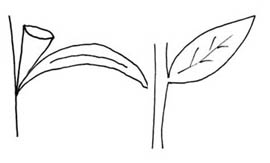 , leaf bladeblade:
, leaf bladeblade:
(n) (syn. lamina) the flat, expanded part of a leaf, frond, or petal (excluding, e.g., the petiole)
 linear or oblanceolateoblanceolate:
linear or oblanceolateoblanceolate:
(adj) lance-shaped, with attachment at or near the narrow end. (compare lanceolate)
, coriaceouscoriaceous:
(adj) thick, tough, leathery
; apexapex:
(n) the point farthest from the point of attachment; the tip (often pointed)
acuteacute:
(adj) tapering to a sharp, pointed apex with more or less straight sides; broader than acuminate; forming an angle of less than 90 degrees ; base straight; marginmargin:
; base straight; marginmargin:
(n) edge; rim
entireentire:
(adj) having a continuous margin that is not toothed or lobed
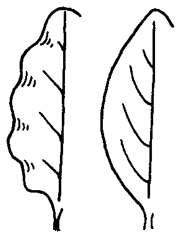 ; venationvenation:
; venationvenation:
(n) the arrangement of veins in a leaf
parallel or midribmidrib:
(n) the main or central vein, line or rib in a leaf or perianth segment
 only. Inflorescenceinflorescence:
only. Inflorescenceinflorescence:
(n) the arrangement of flowers on the floral axis
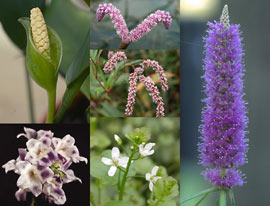 an axillaryaxillary:
an axillaryaxillary:
(adj) in, of, or produced from an axil
umbelumbel:
(n) a flat to convex inflorescence in which the flower pedicels (called rays) all arise from the same point
 ; scapescape:
; scapescape:
(n) a leafless flowering stalk arising from ground level in acaulescent plants
typically solitary, compressed; bracts 2-3, triangular, ovateovate:
(adj) egg-shaped in outline; generally with the broad end at or near the base
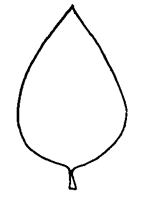 or lanceolatelanceolate:
or lanceolatelanceolate:
(adj) lance-shaped; widest point below the middle, tapering to the apex
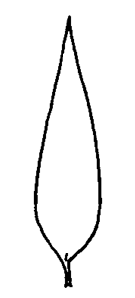 ; floral bracts subulatesubulate:
; floral bracts subulatesubulate:
(adj) awl-shaped; tapering from base to apex
to lanceolatelanceolate:
(adj) lance-shaped; widest point below the middle, tapering to the apex
 . Flowers distinct, fragrant; pedicellatepedicellate:
. Flowers distinct, fragrant; pedicellatepedicellate:
(adj) borne on a pedicel
; tepals linear, reflexedreflexed:
(adj) abruptly curved or bent downward
or ascending, basally fused into a tube, white; androeciumandroecium:
(n) the stamens collectively; the male parts of the flower
basally fused into coronacorona:
(n) a crown-like growth on the inside of the corolla
 , funnelform or rotate, marginmargin:
, funnelform or rotate, marginmargin:
(n) edge; rim
dentate or laceratelacerate:
(adj) torn; irregularly cut or slashed
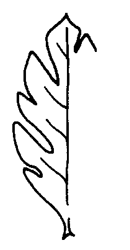 , white; filaments free above, erect to incurved, filiformfiliform:
, white; filaments free above, erect to incurved, filiformfiliform:
(adj) thread-like; long and thin
, green; anthers yellow or orange; stylestyle:
(n) in a flower, the narrow and elongated part of the pistil between the stigma and the ovary
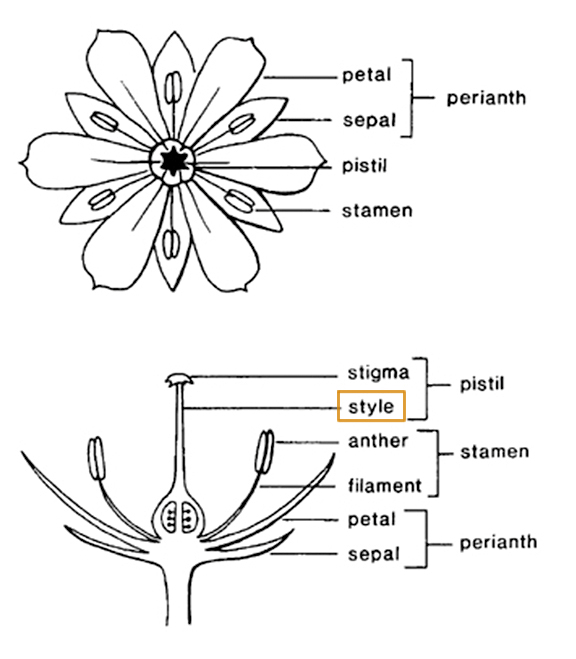 exserted beyond stamens, filiformfiliform:
exserted beyond stamens, filiformfiliform:
(adj) thread-like; long and thin
; stigmastigma:
(n) the portion of the pistil that is receptive to pollen
capitate.
sunny locations along rivers, streams, and swamps, in areas that are shallowly flooded or remain wet during the rainy season
Similar moprhologically to Crinum. Most Hymenocallis species are amphibiousamphibious:
(adj) of a plant able to live on land or in water
and tolerate extended periods of submersion. Because this genus contains various alkaloids, it is not recommended that plant parts be eaten or even touched if allergic. It is difficult to identify species from herbarium specimens; use fresh material whenever possible.